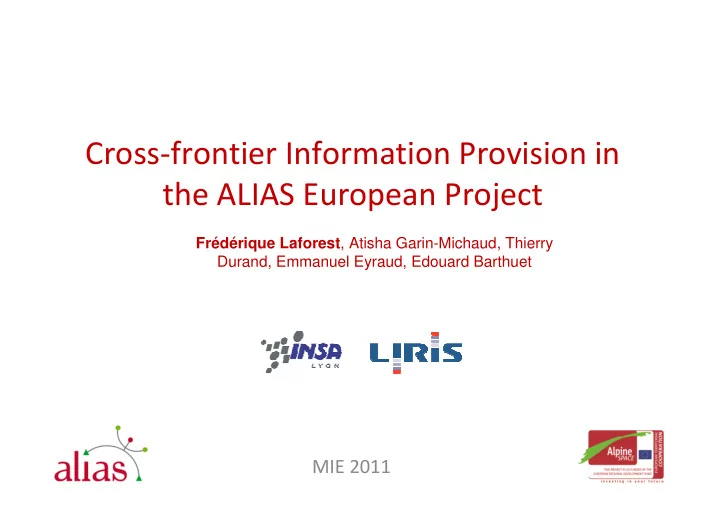

Cross-frontier Information Provision in the ALIAS European Project Frédérique Laforest , Atisha Garin-Michaud, Thierry Durand, Emmanuel Eyraud, Edouard Barthuet MIE 2011 1
Context : the ALIAS project • Alpine Space programme www.alpine-space.eu • 8 hospitals • 6 countries, 4 languages – Austria, France, Germany, Italy, Slovenia, Switzerland • August 2009 - 2012 • Pilot phase October 2011 • Production August 2012 2
Objectives of ALIAS • Foster the exchange of medical knowledge in the Alpine area – Know-how exchange between healthcare professionals – Medical care of mobile patients • Based on existing infrastructures – Hospital and regional EHR platforms • ALIAS proposes the interconnection of existing infrastructures – ALIAS is an exchange platform • Key features – Security of exchanges, strong medical professionals’ identification, patient consent 3
Services in the ALIAS platform • Patient record service – Tools to search and consult patients medical records in the partnering information systems • Medical advice service – Allows a healthcare professional ask for advice on a difficult case to another medical professional in the partnering • Translation service – Translation of exchanged documents for both services 4
Scenario (using ALIAS) • Ana, a Milano (Italy) citizen goes on holidays to Grenoble (France) – She gets a heart attack and is taken in charge in Izola hospital • The slovenian doctor connects to Izola EHR information system and gets access to the ALIAS platform – The doctor enters Ana’s identification information – The doctor gets Ana’s consent and she fills in the corresponding form • The doctor gets access to Ana’s medical record stored in the Milanese platform – Documents are written in Italian, the translation service provides help 5
Agenda • Context and translation needs : the ALIAS project • The translation service – Approach followed – Translation process – Tools used • Conclusion 6
Translation approach • Constraints – Translation at runtime – Exact even if incomplete • full-text translation not adequate – Short delays for pilot phase launching • Conclusions – Partial translation limited to a controlled vocabulary – Translation = Annotation of the original document 7
Vocabularies selection • Translated information and needs – Diseases one controlled list per language – Drugs one controlled list per country • Interoperability of vocabularies – ICD: International Classification of Diseases – ATC : Anatomical Therapeutic Chemical classification • ATC is used as a pivot between the national drugs databanks 8
Translation process 1. Receive and open the document 2. Identify terms 3. Translate terms 4. Enrich the d ocument 9
1.Open the document PDF • Manage only text content Pivot Pivot RTF • Most documents are PDF TIKA TIKA format format • Rtf and txt also TXT Translation • Apache Tika parser to service manage different formats others 10
2. Identification of terms • Using the GATE framework – A global architecture for the processing of text documents – Provides a large set of natural language processing tools – Large vocabularies are manageable using the « Large KB Gazetteer» – Vocabularies must be provided in the OWL format 11
3. Translation • Diseases: direct translation R04 Epistaxis R04 Espistassi R05 Toux R05 Toux … … … … • Drugs: search for equivalent drugs in the country Acido acetilsalicilico B01AC06 ? Kardégic ( ATC: B01AC06 ) Acebutolol ( ATC: C07AB04 ) ( ATC: B01AC06 ) Cardirene ( ATC: B01AC06 ) Ascriptin Cardioaspirin ( ATC: B01AC06 ) 12
4. Showing the augmented document 13
Tools used •For the service development • During the service use 0. Host the service 1. Receive and open the document 2. Identify terms 3. Translate 4. Enrich the document 14
Conclusion Translation of terms in documents • At the moment of document opening • For different formats • Precise translation – Limited to a controlled vocabulary • Under the form of annotations on the original document 15
Perspectives • Towards more semantics – Using the context • Detect negations • Use the logical structure of the document? – Use other vocabularies • SNOMED? • Posology and dosage using ATC-DDD • Next month, run the pilot phase and get first users feedback! 16
Thanks for your attention Questions 17
Recommend
More recommend